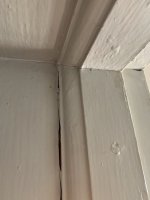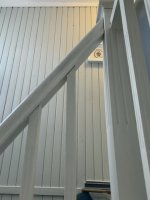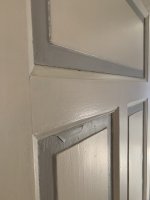FestitaMakool
Member
Hi gals and guys!
I need some buying advise. On the contrary to a lot of you I don’t own too many (FT) sanders, yet..
I’ve got a RO 90 with delta pad, a Bosch 150 Turbo and delta pads on my Makita and Fein multitool.
I’m now nearing more finishing work some places in my house, paint removal/smoothing are first out. But my decision is towards more fitting and carpentry work later on.
So first on my list (and practically in the shopping cart) is the ES-ETSC 125 (Set) I like wireless a lot. But, it will be used with dc most of the time.
Second is a decision between RTSC 400 and DTSC 400. I really like the versatility of the rectangular pad (as I do have enough delta options when the situation calls for it) As do also have the manual sanding pad HSK-A 80x130 that accepts the same paper as the RTSC.
Then to the more difficult decision. I have quite a few challenging surfaces to sand. A variety of mouldings, door frames, doors etc. see photos below.
I’ve had a look at the LS 130 linear sander, it screams buy me - I’m the solution!.
But, a second thought has been: To modify a custom pad for the LS 130 to fit the RTSC and run it like you would with the LS 130. Yes, I’ll have the random and sideways movement, but moving it in strokes straight forward and backwards might work to even the painted surface for re-paint.
I could also finish manually with the custom pad.
It would be very nice to know if any of you have any experience in this regard!
I did forget; generally I haven’t been especially fond of sanding to put it mildly, but the Festool dust collection have been a game changer for me, now sanding is actually enjoyable, sort of [scared] That’s why I’m looking to buy a collection of sanders, that will be used after initial restoration in the house, the ones to keep for woodworking projects. [wink]
Grateful for all your suggestions and experiences!
[attachimg=1]
[attachimg=2]
[attachimg=3]
[attachimg=4]
I need some buying advise. On the contrary to a lot of you I don’t own too many (FT) sanders, yet..
I’ve got a RO 90 with delta pad, a Bosch 150 Turbo and delta pads on my Makita and Fein multitool.
I’m now nearing more finishing work some places in my house, paint removal/smoothing are first out. But my decision is towards more fitting and carpentry work later on.
So first on my list (and practically in the shopping cart) is the ES-ETSC 125 (Set) I like wireless a lot. But, it will be used with dc most of the time.
Second is a decision between RTSC 400 and DTSC 400. I really like the versatility of the rectangular pad (as I do have enough delta options when the situation calls for it) As do also have the manual sanding pad HSK-A 80x130 that accepts the same paper as the RTSC.
Then to the more difficult decision. I have quite a few challenging surfaces to sand. A variety of mouldings, door frames, doors etc. see photos below.
I’ve had a look at the LS 130 linear sander, it screams buy me - I’m the solution!.
But, a second thought has been: To modify a custom pad for the LS 130 to fit the RTSC and run it like you would with the LS 130. Yes, I’ll have the random and sideways movement, but moving it in strokes straight forward and backwards might work to even the painted surface for re-paint.
I could also finish manually with the custom pad.
It would be very nice to know if any of you have any experience in this regard!
I did forget; generally I haven’t been especially fond of sanding to put it mildly, but the Festool dust collection have been a game changer for me, now sanding is actually enjoyable, sort of [scared] That’s why I’m looking to buy a collection of sanders, that will be used after initial restoration in the house, the ones to keep for woodworking projects. [wink]
Grateful for all your suggestions and experiences!
[attachimg=1]
[attachimg=2]
[attachimg=3]
[attachimg=4]





